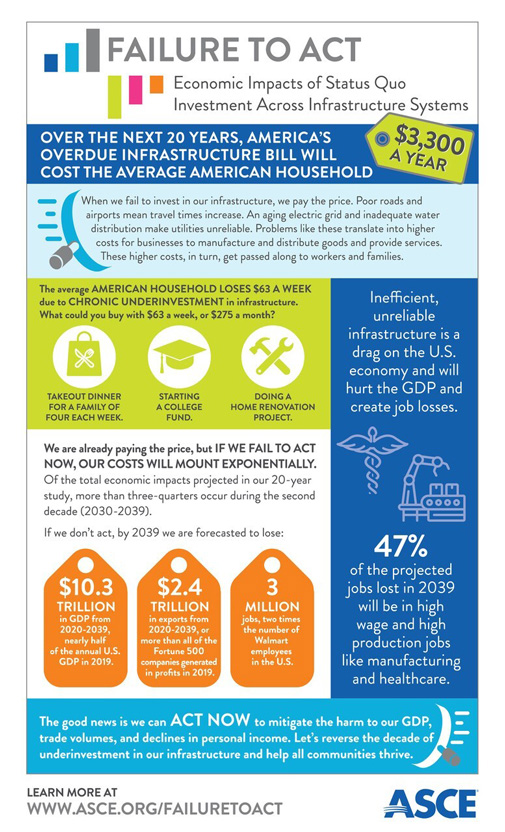Every four years, the American Society of Civil Engineers (ASCE) publishes the “Report Card for America’s Infrastructure,” which grades the current state of national infrastructure categories on a scale of A through F.

Since 1998, America’s infrastructure has persistently earned low grades, and the failure to close the investment gap with needed maintenance and improvements has continued. But the larger question at stake is the implication of low infrastructure on America’s economic future.
The association’s “Failure to Act” report series answers the key question: how does the nation’s failure to act to improve the condition of U.S. infrastructure systems affect the nation’s economic performance? In 2020 and 2021, ASCE released five “Failure to Act” reports in a series covering 11 infrastructure sectors that are critical to the economic prosperity of the United States.
These reports were followed by a fifth, comprehensive final report, “Failure to Act: Economic Impacts of Status Quo Investment Across Infrastructure Systems,” which addressed the aggregate economic impact of failing to act in more than one sector. This report addresses the current infrastructure gaps between today’s needs and investment and how they will affect the future productivity of industries, national competitiveness, and the future costs to households.
“Failure to Act: Economic Impacts of Status Quo Investment Across Infrastructure Systems” quantifies how the persistent failure to invest in our aging infrastructure impacts the economy, including GDP, jobs, personal disposable income, and business sales. The electricity and water/wastewater reports (above) were conducted after this full economic study.
ASCE finds that with an increased investment of $281 billion a year – $5.48 more per household a day – the United States can eliminate this drag on the economy, protecting by 2039:
- $10 trillion in GDP, nearly half of the annual U.S. GDP in 2019.
- More than $23 trillion in total output (primarily business sales).
- More than 3 million jobs in 2039, two times the number of Walmart employees in the United States.
- More than $3,300 in a family’s annual disposable income each year from 2020 to 2039, which is more than half of the average American’s household’s monthly expenditure of $5,102.
“When we fail to invest in our infrastructure, we pay the price,” said ASCE Executive Director Tom Smith.
The group in its annual report card outlined how much infrastructure investment is falling behind. Of the $13 trillion in investment the country needs, only $7.3 trillion is expected, leaving a $5.6 trillion gap. There was a $100 billion increase in the gap of surface transport investment alone over the past four years.
